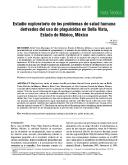Mostrar el registro sencillo del ítem
Estudio exploratorio de los problemas de salud humana derivados del uso de plaguicidas en Bella Vista, Estado de México, México
| dc.contributor.author | Oliva, M. | |
| dc.contributor.author | Rodríguez, J.C. | |
| dc.contributor.author | Silva, G. | |
| dc.date.accessioned | 2015-03-19T21:30:02Z | |
| dc.date.available | 2015-03-19T21:30:02Z | |
| dc.date.issued | 2005 | |
| dc.identifier | 470203 | es_ES |
| dc.identifier.issn | 1659-0082 | es_ES |
| dc.identifier.uri | https://repositorio.catie.ac.cr/handle/11554/6248 | |
| dc.description | Ilus. 19 ref. | es_ES |
| dc.description.abstract | Bella Vista, Municipio de Villa Guerrero, Estado de México, México, es una región agrícola caracterizada por el uso abundante de agroquímicos y la carencia de una cultura de prevención de riesgos en su uso. Con la finalidad de estimar el grado de exposición a plaguicidas y el nivel de conocimientos sobre su manejo seguro, se realizaron encuestas a una muestra estratificada de 25 mujeres, cinco jornaleros, cuatro médicos y cuatro técnicos agrícolas de la citada región. El 60 porciento de las mujeres del campo se sobreexponen a los plaguicidas. La vestimenta que usan para aplicar plaguicidas es la misma que portan en sus actividades domésticas. El 80 porciento de los trabajadores no usa equipo de protección para aplicar agroquímicos y toma sus alimentos en la misma área donde se hicieron las aplicaciones. Los menores de edad se involucran en el uso de plaguicidas. La tasa de fertilidad es de 1,6 hijos por mujer, en comparación con el 2,5 nacional. Los médicos no están preparados para diagnosticar y/o atender a pacientes intoxicados por plaguicidas y no existen programas de capacitación o de prevención de riesgos en el uso de plaguicidas. Bella Vista, Municipality of Villa Guerrero, Estado de Mexico, Mexico, is an agricultural region characterized by an intense use of agrochemicals and lack of a pesticide risk prevention culture. With the aim of estimating the degree of exposition to pesticides and the level of knowledge of their safe use, we carried out a survey of a stratified sample of 25 women, five workmen, four physicians and four agricultural technicians. Sixty percent of the women involved in field work are overexposed to pesticides. The clothes they wear to apply pesticides are also used in domestic activities. Eighty percent of the workers do not use personal protection equipment to apply agrochemicals and they take their meals in the same area where pesticides are applied. Children also applied pesticides. The rate of fertility is 1.6 children per woman, lower than the national average of 2.5. Physicians are not capable of diagnosing and/or attending patients intoxicated by pesticides and there are no training programs to prevent risks in the use of pesticides, either. | es_ES |
| dc.language.iso | es | es_ES |
| dc.publisher | Centro Agronómico Tropical de Investigación y Enseñanza (CATIE), Turrialba (Costa Rica) | es_ES |
| dc.subject | PLAGUICIDAS FUMIGANTES | es_ES |
| dc.subject | SUSTANCIAS TOXICAS | |
| dc.subject | AGENTES NOCIVOS | |
| dc.subject | METODOS DE APLICACION | |
| dc.subject | PELIGRO PARA LA SALUD | |
| dc.subject | CONDICIONES DE TRABAJO | |
| dc.subject | SEGURIDAD EN EL TRABAJO | |
| dc.subject | RIESGOS OCUPACIONALES | |
| dc.subject | SALUD | |
| dc.subject | FERTILIDAD | |
| dc.subject | TASA DE NATALIDAD | |
| dc.subject | PROTECCION DE LA SALUD | |
| dc.subject | ENFERMEDADES HUMANAS | |
| dc.subject | FACTORES DE RIESGO MEXICO | |
| dc.title | Estudio exploratorio de los problemas de salud humana derivados del uso de plaguicidas en Bella Vista, Estado de México, México | es_ES |
| dc.title.alternative | Exploratory study of human health problems derived from pesticide use in Bella Vista, Estado de México, Mexico | es_ES |
| dc.type | Artículo | es_ES |
Ficheros en el ítem
Este ítem aparece en la(s) siguiente(s) colección(ones)
-
Publicaciones y documentos [3628]


